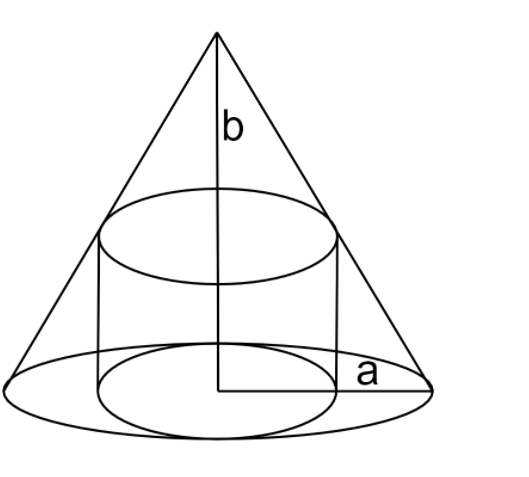
Answer
386.1k+ views
Hint: A cylinder is a solid figure, with a circular or oval base or cross section and straight and parallel sides. It is a closed solid figure with two circular bases that are connected by a curved surface. A cone is a solid three-dimensional figure with a flat circular base from which it tapers smoothly to a point known as the vertex.
Complete step by step solution:

Formulas used in the solution are:
Volume of cylinder \[V = \pi {r^2}h\]
Where \[r\] is the radius of base of the cylinder and \[h\] is the height of the cylinder.
Volume of cone \[ = \dfrac{1}{3}\pi {r^2}h\]
Where \[r\] is the radius of base of the cone and \[h\] is the height of the cone.
Here in this question we are given the following:
The height of cone \[ = h = b\]
The base radius \[ = r = a\]
The base radius of cylinder \[ = r\]
The height of cylinder \[ = h\]
Using similar triangles:
\[\dfrac{h}{{a - r}} = \dfrac{b}{a}\]
Hence we get ,
\[h = \dfrac{b}{a}\left( {a - r} \right) = b - \dfrac{b}{a}r\]
Volume of cylinder \[V = \pi {r^2}h\]
Putting value of \[h\] we get ,
\[V = \pi {r^2}\left[ {b - \dfrac{b}{a}r} \right] \]
\[ = \pi b{r^2} - \dfrac{{\pi b{r^3}}}{a}\]
On differentiating both sides with respect to \[r\] we get ,
\[\dfrac{{dV}}{{dx}} = \dfrac{{2\pi abr - 3\pi b{r^2}}}{a}\] … \[(1)\]
Putting \[\dfrac{{dV}}{{dx}} = 0\]
We get \[\pi br(2a - 3r) = 0\]
Hence we get \[r = \dfrac{{2a}}{3}\]
Differentiating \[(1)\] with respect to \[r\] we get ,
\[\dfrac{{{d^2}V}}{{d{r^2}}} = 2\pi b - \dfrac{{6\pi br}}{a}\]
Putting value of \[r = \dfrac{{2a}}{3}\]
\[\dfrac{{{d^2}V}}{{d{r^2}}} = 2\pi b - \dfrac{{6\pi b}}{a}\left( {\dfrac{{2a}}{3}} \right)\]
\[ = - 2\pi b\]
Therefore \[r = \dfrac{{2a}}{3}\] is a maximum point.
So volume is maximum at \[r = \dfrac{{2a}}{3}\] .
Therefore we get \[h = \dfrac{b}{a}\left( {a - \dfrac{{2a}}{3}} \right) = \dfrac{b}{3}\]
Volume of cylinder \[ = \pi {r^2}h = \pi {\left( {\dfrac{{2a}}{3}} \right)^2}\left( {\dfrac{b}{3}} \right)\]
\[ = \dfrac{4}{9}\left( {\dfrac{1}{3}\pi {a^2}b} \right)\]
\[ = \dfrac{4}{9}\] (volume of cone)
Hence showed.
Note: A cylinder is a solid figure, with a circular or oval base or cross section and straight and parallel sides. It is a closed solid figure with two circular bases that are connected by a curved surface. A cone is a solid three-dimensional figure with a flat circular base from which it tapers smoothly to a point known as the vertex.
Complete step by step solution:

Formulas used in the solution are:
Volume of cylinder \[V = \pi {r^2}h\]
Where \[r\] is the radius of base of the cylinder and \[h\] is the height of the cylinder.
Volume of cone \[ = \dfrac{1}{3}\pi {r^2}h\]
Where \[r\] is the radius of base of the cone and \[h\] is the height of the cone.
Here in this question we are given the following:
The height of cone \[ = h = b\]
The base radius \[ = r = a\]
The base radius of cylinder \[ = r\]
The height of cylinder \[ = h\]
Using similar triangles:
\[\dfrac{h}{{a - r}} = \dfrac{b}{a}\]
Hence we get ,
\[h = \dfrac{b}{a}\left( {a - r} \right) = b - \dfrac{b}{a}r\]
Volume of cylinder \[V = \pi {r^2}h\]
Putting value of \[h\] we get ,
\[V = \pi {r^2}\left[ {b - \dfrac{b}{a}r} \right] \]
\[ = \pi b{r^2} - \dfrac{{\pi b{r^3}}}{a}\]
On differentiating both sides with respect to \[r\] we get ,
\[\dfrac{{dV}}{{dx}} = \dfrac{{2\pi abr - 3\pi b{r^2}}}{a}\] … \[(1)\]
Putting \[\dfrac{{dV}}{{dx}} = 0\]
We get \[\pi br(2a - 3r) = 0\]
Hence we get \[r = \dfrac{{2a}}{3}\]
Differentiating \[(1)\] with respect to \[r\] we get ,
\[\dfrac{{{d^2}V}}{{d{r^2}}} = 2\pi b - \dfrac{{6\pi br}}{a}\]
Putting value of \[r = \dfrac{{2a}}{3}\]
\[\dfrac{{{d^2}V}}{{d{r^2}}} = 2\pi b - \dfrac{{6\pi b}}{a}\left( {\dfrac{{2a}}{3}} \right)\]
\[ = - 2\pi b\]
Therefore \[r = \dfrac{{2a}}{3}\] is a maximum point.
So volume is maximum at \[r = \dfrac{{2a}}{3}\] .
Therefore we get \[h = \dfrac{b}{a}\left( {a - \dfrac{{2a}}{3}} \right) = \dfrac{b}{3}\]
Volume of cylinder \[ = \pi {r^2}h = \pi {\left( {\dfrac{{2a}}{3}} \right)^2}\left( {\dfrac{b}{3}} \right)\]
\[ = \dfrac{4}{9}\left( {\dfrac{1}{3}\pi {a^2}b} \right)\]
\[ = \dfrac{4}{9}\] (volume of cone)
Hence showed.
Note: A cylinder is a solid figure, with a circular or oval base or cross section and straight and parallel sides. It is a closed solid figure with two circular bases that are connected by a curved surface. A cone is a solid three-dimensional figure with a flat circular base from which it tapers smoothly to a point known as the vertex.
Recently Updated Pages
How is abiogenesis theory disproved experimentally class 12 biology CBSE

What is Biological Magnification

Which of the following reagents cannot distinguish class 12 chemistry CBSE

Which of the following reagents cannot distinguish class 12 chemistry CBSE

Which of the following reagents cannot distinguish class 12 chemistry CBSE

Which of the following reagents cannot distinguish class 12 chemistry CBSE

Trending doubts
Which are the Top 10 Largest Countries of the World?

What is the definite integral of zero a constant b class 12 maths CBSE

Differentiate between homogeneous and heterogeneous class 12 chemistry CBSE

What are the major means of transport Explain each class 12 social science CBSE

Explain sex determination in humans with the help of class 12 biology CBSE

How much time does it take to bleed after eating p class 12 biology CBSE




